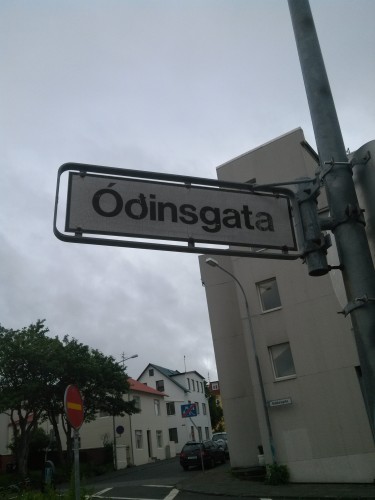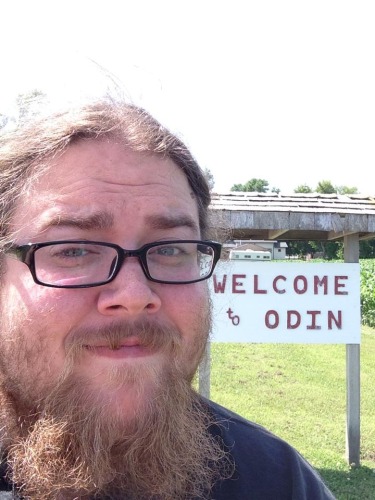
Óðinsgata street sign, Reykjavík, Iceland. Photo by the author.
Hallgrímskirkja sits at the center of downtown Reykjavík, a massive gray slab of church that has, to me, about the same level of architectural charm as the Potosi Correctional Center. It rises up from the street in a concrete wave meant to look like the basalt pillars found elsewhere in Iceland; it has no color to it, and given the cloudiness of Iceland’s skies, often it forms a gray wall against a gray curtain. Although Hallgrímskirkja is probably the most famous building in Reykjavík, I found few reasons to visit it. I am told that for a handful of krónur one can go up into the spire and enjoy a wonderful view of the city, assuming that the fog isn’t too dense. Some of my classmates did this, and reported having a lovely experience, but I never made the trip myself. This was, in part, because my Heathen character found the idea distasteful – I mean, I didn’t come to Iceland to spend time in churches. The other part is that I didn’t have any handfuls of krónur to spare.
But I spent quite a lot of time in the neighborhood around Hallgrímskirkja, all the same. The neighborhood around the church is called Goðahverfið, or, as a handy placard notes, “The Neighborhood of the Gods.” The streets to the west of the church are all named for the Norse gods. Not 500 feet from the doors of the most impressive Christian edifice on the island sit streets named for Thor and Freyja. The metaphor almost seems too obvious. I remember something that my friend Kári, a member of Ásatrúarfélagið, said: I think the reason Ásatrú comes so easily to us is because we were never very good Christians in the first place.
I made an afternoon of walking the Neighborhood of the Gods one day after my morning Icelandic class let out, taking pictures of every street sign that bore some relation to the myths. (I justified this as a way of studying noun declensions. Freyjugata – weak feminine noun; you can tell by the way Freyja becomes Freyju. Njarðargata – the ö in Njörður becomes an a in the genitive.) The selection of deities seemed to me odd and fragmentary. Most of the major deities have streets – Óðinsgata, Þórsgata, and so on – and so do many of the more obscure figures – Fjölnisvegur, named for Fjölnir, a son of Freyr named in Ynglinga Saga, and Sjafnargata, for Sjöfn, a goddess mentioned a few times in Snorri’s Edda. But some others are looked over. Freyr himself, for instance, has no street. Neither does Frigg. Urður gets one, but not Skuld or Verðandi. I don’t pretend to have an explanation for this, except that perhaps having Freyjugata, Freysgata, and Friggjargata within a three-block area would have made giving directions to foreigners a nightmare.
Other than the signs, there’s nothing especially significant in the Neighborhood of the Gods to draw the eye of a mythology buff. Even the signs themselves are mostly just fun to look in a scavenger-hunt kind of way, though there were a few intersections and parallels that caught my attention – the intersection of Baldursgata and Nönnugata is sweet in a sad way, and, as Karl Siegfried at the Norse Mythology blog has pointed out, it’s amusing that Lokastígur is hidden behind Þórsgata, just as Loki always seems to be working at something behind Thor’s back. But I never found any hidden statues or secret shrines there; it is, for the most part, just another neighborhood in Reykjavík.
And yet there is something in it that pulls at me. It’s the magic of the names. Óðinsgata is Óðinsgata; it’s a street named for the god I spend the most time thinking about. I wanted to see that street sign with my own eyes almost as much as I wanted to see Þingvellir or Skógafoss. It’s just the name of the street. But that name was enough to lure me to it.
The name was also enough to make me visit Odin, Minnesota, a postage-stamp of a town about 35 miles north of the Iowa border. Odin was about two and a half hours out of my way on the drive from Minneapolis to Missouri, which was otherwise a straight shot down I-35. I took the country highways out past St. Peter and Mankato and found myself approaching Odin a little after noon.
Nothing in Odin drew a connection between the town and its namesake, except perhaps for a yellow “NORWEGIAN X-ING” sign hanging on one of the electric poles. The Neighborhood of the Gods at least had a plaque and the Guesthouse Odinn; Odin, MN, just had a cheery red-on-white sign that read “WELCOME TO ODIN.” I wandered around for a few minutes, taking pictures of the Odin Community Center and Fire Hall, the Odin State Bank, the Odin Post Office. (Alas, no First Church of Odin, which was of course my real desire.) The town seemed empty – nobody on the streets at all.
I walked over to the Odin General Store and Bait Shop. I opened the door and found that apparently everybody in the city was there too, standing around folding tables; it looked like they had just finished lunch. Perhaps it was a regular Sunday gathering. The room was dark, and even though it seemed like it was the closest thing to a grocery store around, there were only a couple of shelves holding dry goods and a freezer with sodas and Hot Pockets. I drew stares. I don’t think they saw many tourists there. I paid for a Cherry Coke and left.
It’s been six months now since I returned home from my trip to the north, and I still think about that seemingly uneventful visit to Odin, MN, nearly every day. We give things names to connect ourselves to them, because the name has meanings beyond what it appears to signify. Odin is a one-eyed god, and Odin is a town of 100 people in southern Minnesota, and Odin is a street in downtown Reykjavík. And Odin is the space in my mind where these three things, and three thousand other things, intersect, meld, and are sent forth again.
I remember driving away from Odin, a few moments after I took an obligatory selfie next to the welcome sign. I watched that sign recede into the distance in my rearview mirror as I began my journey southward, signaling the end of one pilgrimage, marking the beginning of whatever came next.

#odinselfie
The Wild Hunt is not responsible for links to external content.
To join a conversation on this post:
Visit our The Wild Hunt subreddit! Point your favorite browser to https://www.reddit.com/r/The_Wild_Hunt_News/, then click “JOIN”. Make sure to click the bell, too, to be notified of new articles posted to our subreddit.
Neat !
It’s been too long since your last post. Please write more often!
Otherwise, I liked this article because I used to cross the neighborhood every day when I lived in Reykjavík in order to get to the University. Those names are pretty neat to think about indeed! I would maybe have also mentioned Café Loki which is pretty cozy and Týsgata, which leads to Þórsgata.
In Norway where I live there also are numerous modern “theoforic” place-names. In my town, a whole neighborhood is called Åsgård. Incidentally enough, this is where the psychiatric hospital is situated so we sometimes jokingly refer to Åsgård as a literal madhouse.
Anyway, keep up the good work !
Loving the epic beard, considering regrowing mine (it was almost long enough to braid :). Keep the stories coming!
I also thought the same thing. That’s an epic beard we have here…I am quite jealous !
I love your writing!
I totally understand the attraction to these names. I live in Spokane, WA, and we have two big streets here called Thor and Freya and I also feel drawn to these streets, even though I know there’s nothing to set them apart from any other street in the city other than their names. Names have power!
As always, you take us along on an interesting journey.
Yesterday, I discovered the town of Gimli, Manitoba, Canada, through an interview with a Canadian whisky expert, conducted by my booze-pusher. It’s a settlement of Icelanders (do they have decent skyr there?) who celebrate their heritage. Apparently, it’s also an (Old?) Norse name, said language being a major influence on the Professor’s language building.
Here it is, Stanza 61 of Völuspá.
I am really enjoying your travel blogging and look forward to more.